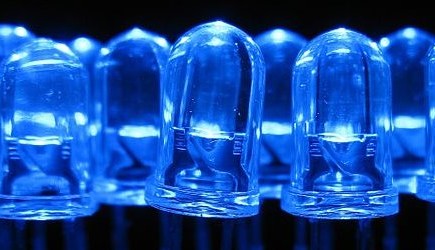Wireless Data Transfer Over Visible Light Sets New Record at 10 Gb/s
October 31, 2013
on
on

British researchers have transmitted wireless data at speeds of over 10 gigabits per second using LED lights. It is the latest breakthrough in the emerging field of Visible Light Communication (VLC).
VLC uses the visible light portion of the electromagnetic spectrum to transmit data. When the technology matures visible light could become an additional medium next to radio waves for wireless communication.
The researchers used arrays of micro-LEDs developed at the University of Strathclyde, Glasgow. The light emitted by micro-LEDs is modulated at high speeds to create a binary sequence. A receiver converts the light sequence into an electrical signal and feeds it to a computer or mobile device. Each of the elements in the array transmit a unique binary sequence at the same time. These parallel data streams are the reason the team can achieve such high speeds.
The Strathclyde University collaborates on the VLC technology with four other UK universities as part of the Ultra Parallel Visible Light Communications project. It runs from 2012 to 2016 and has received £4.6 million (€5.3, $7.4) in funding.
VLC would be a welcome addition to RF data transmission. It can ease the strain on the over-crowded radio frequencies. Visible light is also more energy efficient than radio signaling because it does not require energy-hungry base stations.
The light bulbs used for VLC double as normal illuminators. The infrastructure for VLC is already in place, with a few adjustments the lights installed in homes and offices can function as data transmitters.
In some instances VLC can also be more secure than radio technology like Wi-Fi. Wi-Fi needs to be encrypted because anyone in range can eavesdrop on the signal. But light can't travel through walls so what's transmitted indoors, stays indoors.
VLC uses the visible light portion of the electromagnetic spectrum to transmit data. When the technology matures visible light could become an additional medium next to radio waves for wireless communication.
The researchers used arrays of micro-LEDs developed at the University of Strathclyde, Glasgow. The light emitted by micro-LEDs is modulated at high speeds to create a binary sequence. A receiver converts the light sequence into an electrical signal and feeds it to a computer or mobile device. Each of the elements in the array transmit a unique binary sequence at the same time. These parallel data streams are the reason the team can achieve such high speeds.
The Strathclyde University collaborates on the VLC technology with four other UK universities as part of the Ultra Parallel Visible Light Communications project. It runs from 2012 to 2016 and has received £4.6 million (€5.3, $7.4) in funding.
VLC would be a welcome addition to RF data transmission. It can ease the strain on the over-crowded radio frequencies. Visible light is also more energy efficient than radio signaling because it does not require energy-hungry base stations.
The light bulbs used for VLC double as normal illuminators. The infrastructure for VLC is already in place, with a few adjustments the lights installed in homes and offices can function as data transmitters.
In some instances VLC can also be more secure than radio technology like Wi-Fi. Wi-Fi needs to be encrypted because anyone in range can eavesdrop on the signal. But light can't travel through walls so what's transmitted indoors, stays indoors.
Read full article
Hide full article


Discussion (1 comment)